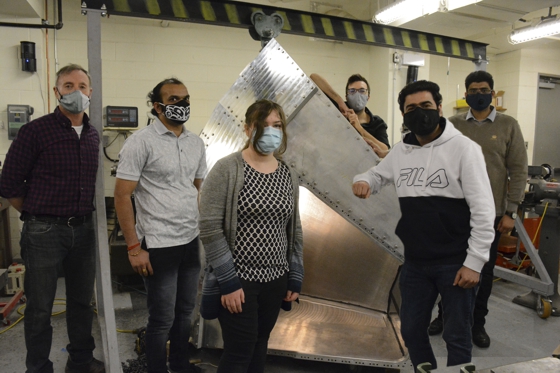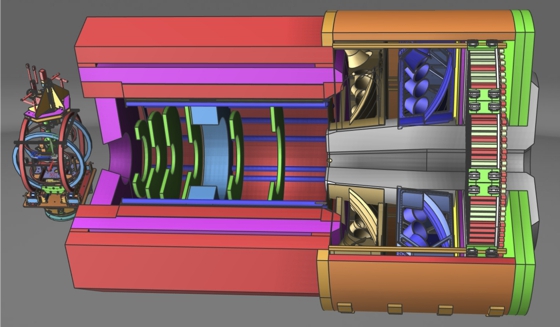Get Mobile
- Read news and events on the Official Student App
Join Us
Physics Department contributes prototype for ‘quantum leap’ detector
Posted: March 31, 2021 5:00 a.m.

Physics professor Garth Huber (left) and his student team are constructing part of the Solenoidal Large Intensity Device that will be housed at the Jefferson Lab in Virginia. (Students left to right: Vijay Kumar, PhD physics student, Emma Kirby, undergraduate physics Co-Op student, Stephen Kay, postdoctoral Fellow, Ali Usman, PhD physics student, Muhammad Junaid, PhD physics student. Photo courtesy of Garth Huber
|
The University of Regina’s Department of Physics is contributing to the construction of one of the world’s most powerful microscopes, or detectors, the Solenoidal Large Intensity Device, or SoLID.
“It’s described as a ‘quantum leap’ in technology over and above any current or proposed detector,” says Garth Huber, professor of physics.
Scheduled to be built between 2022 and 2025 and housed in the renowned Jefferson Lab in Virginia, SoLID will cost $70 million USD. Currently under review for approval by the U.S. government, the creation of the device is an international, collaborative project, with 300 members from 72 institutions in 13 countries.
For the past five years, U of R physics students have worked on constructing a prototype of a critical component of the device – the Heavy Gas Cherenkov (HGC) detector. Located at what will be the back of SoLID, the HGC will hold high-pressure freon gas and generate Cherenkov radiation. The light from the radiation will help physicists identify the particles that go through SoLID.
“We’re probing into the very heart of matter,” says Huber. “You have the atom and inside you have the nucleus. We're looking at probing deep inside the nucleus.”
 |
|
The HGC detector is the blue area located |
Building the prototype has come with its challenges. Freon is expensive, so the HGC detector must not leak. At the same time, the material of the detector must be thin enough that it does not interact with the particles passing through it. Of particular concern is the front window on the HGC detector. Two different versions have been made for testing, one made of carbon fiber epoxy, and the other of thin aerospace-grade aluminum alloy.
Stephen Kay, a postdoctoral fellow, supervised the tests students undertook to assess the pressure and leakage of the window on the prototype. The students used simple tools: a bike pump and a spray bottle full of soap.
“People think it's going to be all high-tech, but no, it's simple and it works,” he says.
After inflating the prototype with the bike pump, students sprayed the surface of the window and its frame with the soapy water. If bubbles formed in an area, that indicated a leak.
Kay says the hands-on experience is valuable for the physics students. “Sometimes, in our field, it's easy to be pigeonholed and sit behind a desk doing one thing,” he says. “I think this work gives them a better understanding of what they're actually looking at when they look at their data.”
Emma Kirby, from Teulon, Manitoba, is a third-year physics student at the university. She is completing her co-op placement with the Physics Department this spring. Her main task has been documenting the tests on the prototype detector and making it leakproof with a silicone caulking material. To check for leaks on the larger prototype, students use a natural gas detector once the vessel is filled with a mixture of compressed air and a small amount of hydrogen.
“It's really exciting to think of what the final result is going to be. I guess it also makes me a little bit nervous too, cause it's a lot of gas pressure,” says Kirby.
Though SoLID will not start running experiments until 2028, Huber and Kay are excited by the opportunities the device presents for their field.
Huber plans to conduct an experiment that he has been thinking about for nearly twenty years: investigating why the spin of the neutron always equals one half. He’s seeking to establish why a complicated set of internal quark-gluon processes give rise to such a simple quantum number describing the spin.
“One of the big questions in subatomic physics is to understand, at the most basic level, the structure of the proton and the neutron,” he says. “Why is it that size, why does it have exactly that amount of charge, that amount of spin, that amount of magnetization?”
“It’s a very exciting time in our field,” says Kay, who also mentions that the U of R has made an “oversized contribution” over the past several years because of its strong relationship with Jefferson Lab. It works on three of the four halls in the lab and contributed vital research as part of the GlueX project in 2017.
Kay learned something new as a post doc fellow through his work on SoLID. He was deeply involved in the process of putting together requests for tender from machining companies to build the prototype. Kay is from the U.K. and says Huber viewed it as an opportunity for Kay to learn how the process works in Canada.
“Garth was quite keen to make sure that not just the students receive a well-rounded experience, but also the post docs he supervises as well,” he says.
The HGC detector prototype was built by Industrial Machine and Manufacturing, Inc., in Saskatoon. The real HGC detector will be built in stages from 2024 to 2026.
The U of R Physics Department worked collaboratively with students and researchers from Duke University on the HGC detector prototype. While the U of R was responsible for manufacturing the vessel and making it leakproof, Duke tested the sensors inside it that will pick up the Cherenkov radiation.
The prototype was funded by the Canada Foundation for Innovation John R. Evans Leaders Fund, the Sylvia Fedoruk Canadian Centre for Nuclear Innovation, and the University of Regina.

